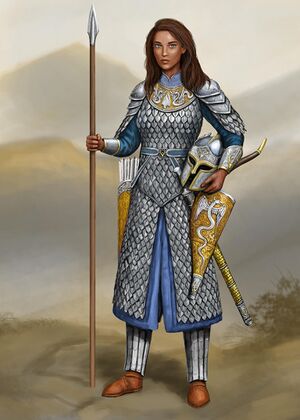Kamadyu the Magnificent
| Kamadyu | |
|---|---|
| Basilissa (Hellene) Bāmbusht (Khaltian) Virajni (Classical Kankrit) | |
 Artist depiction of Kamadyu in battle gear. | |
| Reign | 259 - 299 |
| Predecessor | Hritsvashaya |
| Dynasty | Kadipsus |
| Religion | Buddhism Kalaism |
Kamadyu of Hannashka, commonly known as Kamadyu the Magnificent, was an empress in the latter half of the Hannashka Empire's sovereignty over parts of Tennai and a large expanse of southwest Siduri. She was the daughter of Hritsvashaya and her mother was Amba.
Before her accession, Kamadyu served as a low-ranking officer in the Hannashka army. She served in numerous battles against the Makedonian Empire and other smaller nations. Kamadyu also traveled extensively outside of the battlefield and was tutored extensively in many subjects.
Under her rule, the empire enjoyed great military success, reconquering lands lost to the Makedonian Empire in prior wars and also expanding into new territories. The terrirorial gained under Kamadyu's rule would, for the most part, remain under Hannashka control until the Rideva Empire conquered much of the Hannashka Empire's territory in the last decade of the 4th century. Kamadyu's territorial expansion secured the section of the Spice Road that linked the Sabri Sea with the Varuna Ocean and allowed for the safe passage of merchants across a vast expanse of southern Siduri.
Background
Kamadyu was the youngest child of daughter of Emperor Hritsvashaya and low-ranking concubine of northern Tennaiite descent, Amba. From her mother she had three brothers named Bhoja, Satrajit, and Pathina. She also had three sister named Satyabhama, Devaki, and Karenumati. Almost nothing is known of her mother's family except that they were from the city of Ajmer, modern day Sewa. Ajmer was known at the time for its excellent ironworking. Many historians postulate that Kamadyu's mother was from high ranking family and was made a concubine to help maintain the the loyalty of Ajmer and thus secure a supply of high quality iron goods. It was not uncommon for Hannashka emperors and empresses to taken wifes, husbands, and concubines from the powerful and wealthy familys of its subject peoples to help maintain thier loyalty.
Early Life
Military
At the age of 17, Kamadyu was given command of a small contingent of troops by her father and sent to engage with Makedonian forces at the frontier of the two empires. With her small contingent of 250 heavy cavalry, 700 horse archers, and 1000 levy infantry she managed to inflict heavy losses on the Makedonian forces that greatly outnumberd her own. The account of one battle describes Kamadyu squaring off with a Makedonian force of 7,500 and inflicting severe casualities in the number of 3,100 dead and 3,000 wounded on the Makedonian side and only 150 dead and 100 wounded from Kamadyu's force. The accuracy such accounts can be held up to scrutitiny, but both Helene and Kalkrit sources agree that Kamadyu was highly successful.
Two years later at the age of 19 and after continued success, Kamadyu's force was reduced to that of 300 medium cavalry and she was sent out again to engage the forces of both Erani petty kingdoms and Makedon. Lacking the numbers to engage in pitched battles, Kamadyu engaged in hit-and-run warfare, skillfully utilizing the flexibility and skill of her medium cavalry. Using this style of warfare she was able to inflict significant losses over time while suffering very few casualties herself.
Scholars have debated the reason for Kamadyu being given such small commands and subsequently engaging far supior forces for many centuries. The most prominent theory holds that as the daughter of a low ranking concubine and possessing great charisma and ambition she was viewed as a threat by Hritsvashaya and his potential heirs. Thusly, sending Kamadyu to engage much larger forces with very limited resources was intended to kill off a potential rival to the throne without having to execute her and causing unrest within the imperial household and among subject populations.
Education and Travel
Prior to and during her early militry life, Kamadyu was educated by a group of three Buddhist monks headed by Mahanta and the Kalaist purohit and scholar Narumai.